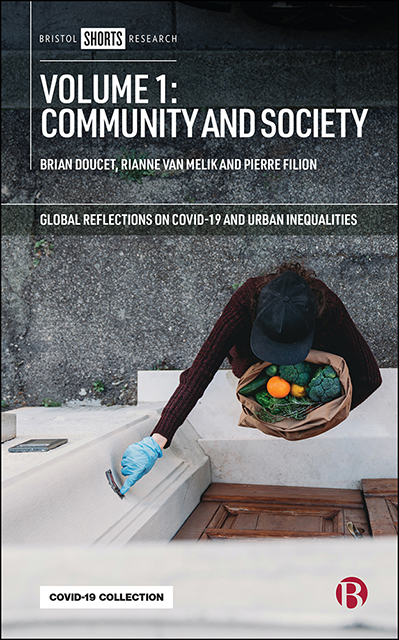Book contents
- Frontmatter
- Contents
- List of Figures and Tables
- Notes on Contributors
- Acknowledgments
- Preface to All Four Volumes of Global Reflections on COVID-19 and Urban Inequalities
- One Introduction
- Part I Working Practices
- Part II Life During Lockdown
- Part III Migration, Migrants, and Refugees
- Part IV Age, Race, Gender, and Ability
- Index
Seventeen - Experiential Equity: An Environmental Neuroscientific Lens for Disparities in Urban Stress
Published online by Cambridge University Press: 13 April 2023
- Frontmatter
- Contents
- List of Figures and Tables
- Notes on Contributors
- Acknowledgments
- Preface to All Four Volumes of Global Reflections on COVID-19 and Urban Inequalities
- One Introduction
- Part I Working Practices
- Part II Life During Lockdown
- Part III Migration, Migrants, and Refugees
- Part IV Age, Race, Gender, and Ability
- Index
Summary
Urban stress
This pandemic has highlighted and demonstrated the bidirectional relationship between urban design and stress. At a very fundamental level, COVID-19, a communicable disease, has shifted how we engage with urban environments; places of connection that once brought joy may now be seen as places that expose us to threat of the disease. The term ‘pandemicrelated stress’ refers to the stress and anxiety associated with contracting the illness, passing the illness onto others, as well as the financial stress associated with the pandemic's impact on the economy (Barzilay et al, 2020). As other chapters in this volume have emphasized, these impacts and their associated stresses vary considerably due to intersecting identities and geographies. There are many unknowns during the pandemic which have driven a sense of uncertainty and stress (Hirsch et al, 2012).
How, then, can we address this stress, which is a detrimental threat to central life goals? Considering that the threat of spreading, or contracting, the virus is primarily dependent on proximity to others within indoor spaces, the use of outdoor space, including both private and public spaces, could be seen as a way to mitigate pandemic-related stress. To help ensure the physical and mental well-being of residents, many cities have adapted their public spaces and built environments in order to increase the amount of open and public space available to use (see Volume 3). This has been done through the closing down of roadways to cars, implementing new bike lanes and, as more was learned about virus transmission, encouraging the use of park spaces. This outdoor-focused approach has been lauded as a necessary strategy to enhance and support physical and mental well-being (Mees, 2020; Mazumder, 2020). These open-air interventions, arguably, are also ways to help manage the perception and experience of the threat of contracting or spreading the virus. Furthermore, the exposure to greenspace has been found to be associated with a reduction in physiological measures of stress (Grahn and Stigsdotter, 2010). Access to, and experience of, public space, then, can be seen as a reliable and scalable solution to pandemic-related stress.
However, it is important to consider that not everyone experiences public space similarly, and that the pandemic is not the sole threat to safety (Beeckmans and Oosterlynck, Volume Three; Whitten and Massini, Volume Three; Rodriguez et al, Volume Three).
- Type
- Chapter
- Information
- Volume 1: Community and Society , pp. 187 - 196Publisher: Bristol University PressPrint publication year: 2021

